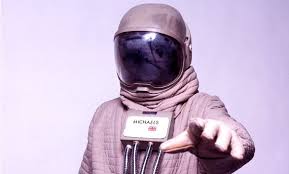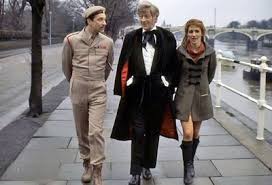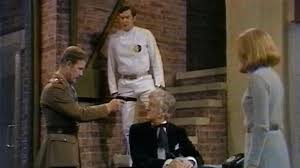 “The Ambassadors of Death” is perhaps Malcolm Hulke’s least satisfactory contribution to Doctor Who. Originally called “The Carriers of Death,” the serial started life as a commission for David Whitaker in 1968. Whitaker was Doctor Who‘s first story editor, overseeing some 51 episodes in the series’ first year. He also wrote a number of serials, including “The Crusade” (1965), “The Power of the Daleks” (1966) and “The Wheel in Space” (1968).
“The Ambassadors of Death” is perhaps Malcolm Hulke’s least satisfactory contribution to Doctor Who. Originally called “The Carriers of Death,” the serial started life as a commission for David Whitaker in 1968. Whitaker was Doctor Who‘s first story editor, overseeing some 51 episodes in the series’ first year. He also wrote a number of serials, including “The Crusade” (1965), “The Power of the Daleks” (1966) and “The Wheel in Space” (1968).
Despite this pedigree Whitaker’s script on the theme of aliens landing on Earth was deemed unsatisfactory by the production team: his rewrites even less so. Eventually script editor Terrance Dicks decided that Whitaker was never going to be able to produce a satisfactory script: it was agreed in November 1969 that he would be paid for his work and a new writer brought in. Whitaker would still be credited as the writer, which seems quite generous. According to Dicks, Whitaker was quite relieved at being off the story.
Dicks now called in his old friend Mac Hulke, with whom he had worked on The Avengers in the early 1960s and on “The War Games,” a 10 week serial which they wrote together at great haste in early 1969, and featured Patrick Troughton’s final appearance as The Doctor. It seems that Terrance and Mac worked together on this seven part serial, now renamed “The Ambassadors of Death.”
 The story centres on a British spaceship Recovery Seven, sent into space to investigate what has happened to the previous Mars Probe Seven. It locates the ship, but then stops communicating. The Doctor and the Brigadier are called in, who succeed in tracing a mysterious signal sent to the Probe from Earth to a warehouse where a gun battle takes place with a number of military men commanded by a General Carrington.
The story centres on a British spaceship Recovery Seven, sent into space to investigate what has happened to the previous Mars Probe Seven. It locates the ship, but then stops communicating. The Doctor and the Brigadier are called in, who succeed in tracing a mysterious signal sent to the Probe from Earth to a warehouse where a gun battle takes place with a number of military men commanded by a General Carrington.
Probe Seven returns to Earth with three occupants, who are seized by Carrington’s men in a dramatic scene. Carrington tells the Doctor and the Brigadier that it was neccessary to put the astronauts into protective custody as they had been infected by radiation. However, the Doctor believes that they are not the human astronauts. They are now seized by Reegan, a man working for Carrington, and kept in a sealed room where they are fed radiation.
The Doctor goes into space and is taken into an alien ship where he discovers that the earth astronauts are on board. T he astronauts on Earth are in fact ambassadors from the aliens, who threaten war unless they are returned. Reegan kidnaps the Doctor’s assistant, Dr. Liz Shaw, and makes her work looking after the astronauts. He forces the aliens to carry out raids, killing people with a single touch with intense radiation, and also kidnaps the Doctor when he returns to Earth.
Meanwhile Carrington is planning a global television broadcast. We learn that he was on a previous Mars probe when his fellow astronaut was killed by a touch from the aliens, and he believes that they are a threat to the whole world. He intends to show them on television and call on the world to destroy the alien ship. The Doctor and Liz are rescued by the Brigadier and stop the broadcast. Carrington is taken into custody: the aliens will be returned to their ship.
One of the familar themes in Mac Hulke’s work, derived perhaps from his membership of the Communist Party, is the notion that what we are being shown or being told is not really what is going. His work for Doctor Who often features a conspiracy which is manipulating events from behind the scenes. In this serial and in “Invasion of the Dinosaurs” it’s soldiers, politicians and scientists; in ” Frontier in Space” it’s the Daleks; in “Colony in Space” it’s the IMC mining expedition.
The Doctor plays much the same role as he did in “The Silurians,” seeking to mediate and prevent conflict. He tells the alien commander; “Now let me go back to Earth and I will give you my personal l assurances that your ambassadors will be retuned to you.” And is often the case in Mac Huike’s work even the anti-hero Carrington is shown driven not by personal greed or adesire for power, but a mistaken belief in an alien threat.
Carrington: I had to do what I did. It was my moral duty. You do understand don’t you?
The Doctor; Yes, General. I understand.
There is a big nod to the first Quatermass serial The Quatermass Experiment (1953) in which a space expedition returns to Earth with a single astronaut instead of the three sent into space; it transpires that an infection from space has merged them into a single alien entity.
The idea of the astronauts carrying out raids and killing with a single touch harks back to two Avengers serials: “The Cybernauts” (1965) in which a robot created by Dr. Clement Armstrong (Michael Gough) is sent to kill his business rivals; and The Positive Negative Man (1967) in which a scientist (Ray McNally) harnesses electricity within a human body and sends out a man to kill with a touch.
 What might have worked as a four part serial becomes quite threadbare when stretched over seven parts, leaving the viewer sufficient to time to ponder on some of the more improbable aspects of the plot. Why is the space control centre in charge of the Mars probe expedition run by just four people? If the aliens are so powerful – judging by the size of their ship – why not simply swoop down and rescue their ambassadors? Why is Reegan single-handedly able to run rings around UNIT, kidnapping and killing at will? Why is the space scientist Taltalian, who holds the Doctor and Liz Shaw at gunpoint in episode 2, allowed to carry on working there and the incident forgotten, after which he plants a bomb and tries to blow up the Doctor? And finally where did Liz Shaw buy her stylish hat?
What might have worked as a four part serial becomes quite threadbare when stretched over seven parts, leaving the viewer sufficient to time to ponder on some of the more improbable aspects of the plot. Why is the space control centre in charge of the Mars probe expedition run by just four people? If the aliens are so powerful – judging by the size of their ship – why not simply swoop down and rescue their ambassadors? Why is Reegan single-handedly able to run rings around UNIT, kidnapping and killing at will? Why is the space scientist Taltalian, who holds the Doctor and Liz Shaw at gunpoint in episode 2, allowed to carry on working there and the incident forgotten, after which he plants a bomb and tries to blow up the Doctor? And finally where did Liz Shaw buy her stylish hat?
The serial enlivened by the set piece action sequences ie the gun fight in the warehouse and the seizure of the capsule in which Havoc, the stunt company run by Derek Ware, pulls out all the stops and turn the scenes into something resembling a James Bond film on a fraction of the budget. Liz Shaw (or rather Roy Scammell, a stuntman standing in for Caroline John) is dramatically chased by villains across Marlow Weir. The outdoor scenes with the astronauts shot against a low sun, with accompanying eerie music, work well, also shot in Marlow at the Little Marlow sewage works.
I was surprised on watching it again at the level of casual violence in a children’s tea-time serial. For instance two of Reegan’s operatives die from radiation when they get into a van with the aliens and are just dumped in a gravel pit. Perhaps we teenagers in the 1970s were tougher than today…
Overall not a classic.

 In episode two, as UNIT head to the caves equipped with small arms and grenades, the Doctor comments to his companion Liz Shaw,“That’s typical of the military mind, isn’t it? Present them with a new problem and they start shooting at it” adding “It’s not the only way you know, blasting away at things.”
In episode two, as UNIT head to the caves equipped with small arms and grenades, the Doctor comments to his companion Liz Shaw,“That’s typical of the military mind, isn’t it? Present them with a new problem and they start shooting at it” adding “It’s not the only way you know, blasting away at things.” In episode six, as the Doctor races to find a cure for the plague, he is still hoping for a peaceful outcome, pleading that “at all costs we must avoid a pitched battle.” In the seventh and final episode the Doctor tells the Brigadier that he wants to revive the Silurians one at a time, “there is a wealth of scientific knowledge down here..and I can’t wait to get started on it.”. But unknown to the Doctor , UNIT has planted explosives which detonate as he and Liz look across the moor.
In episode six, as the Doctor races to find a cure for the plague, he is still hoping for a peaceful outcome, pleading that “at all costs we must avoid a pitched battle.” In the seventh and final episode the Doctor tells the Brigadier that he wants to revive the Silurians one at a time, “there is a wealth of scientific knowledge down here..and I can’t wait to get started on it.”. But unknown to the Doctor , UNIT has planted explosives which detonate as he and Liz look across the moor. Finally the Doctor’s companion Liz has been given a bit of a makeover from “Spearhead from Space”, no longer quite as prim and proper, now sporting fashionable short skirts and longer hair. She is often the only woman in a world of men – soldiers, scientists, civil servants etc – who frequently patronise her, and she has to assert herself. In episode two she objects to being left behind when the rest of them head off to the caves, asking the Brigadier, “Have you never heard of women’s emancipation?” In episode four she does go into the caves with the Doctor. In episode six , when the Brigadier asks her to man the phones Liz snaps back, “I am scientist, not an office boy.” In 1970 the
Finally the Doctor’s companion Liz has been given a bit of a makeover from “Spearhead from Space”, no longer quite as prim and proper, now sporting fashionable short skirts and longer hair. She is often the only woman in a world of men – soldiers, scientists, civil servants etc – who frequently patronise her, and she has to assert herself. In episode two she objects to being left behind when the rest of them head off to the caves, asking the Brigadier, “Have you never heard of women’s emancipation?” In episode four she does go into the caves with the Doctor. In episode six , when the Brigadier asks her to man the phones Liz snaps back, “I am scientist, not an office boy.” In 1970 the